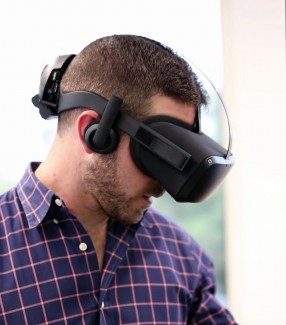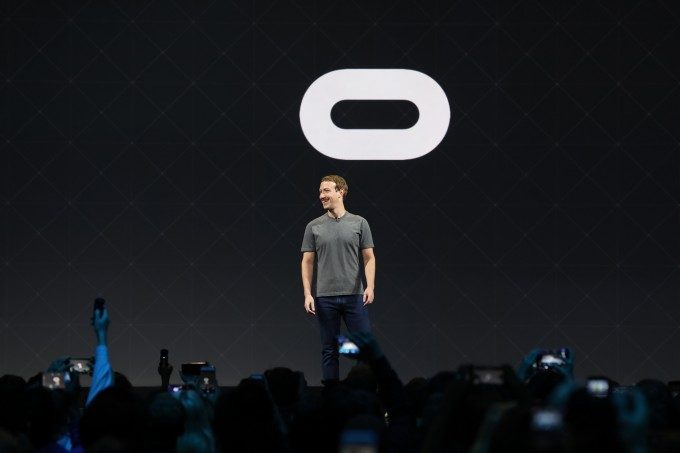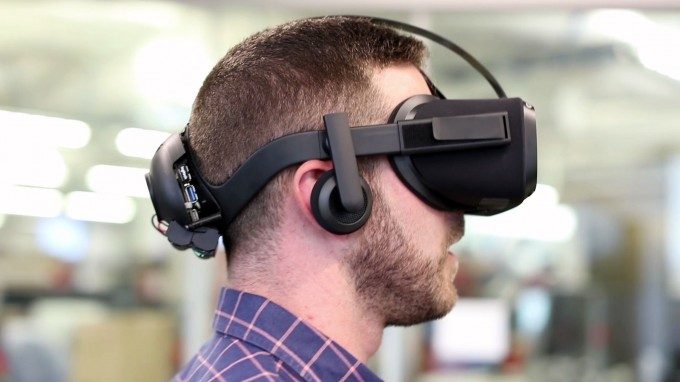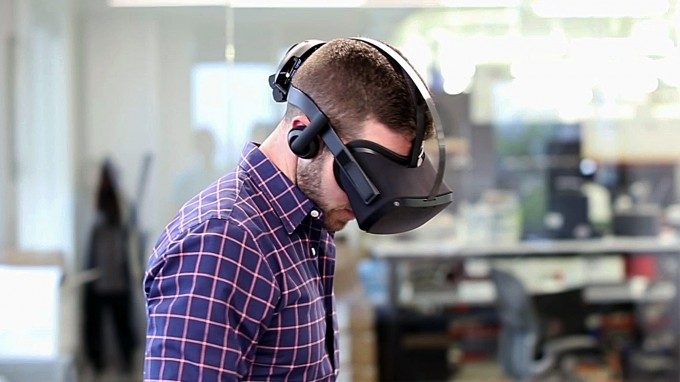On stage at Oculus Connect 2016, Facebook CEO Mark Zuckerberg teased that Oculus is developing a new, standalone, wireless VR headset with inside-out positional tracking. Following the keynote, I was whisked away behind closed doors to see the so-called ‘Santa Cruz’ prototype in action.
A big “NO CAMERAS” sign is not something that I usually see as a member of press, yet it’s the first thing that greeted me after I was hurried through a nondescript pair of doors at the San Jose Convention Center.
Inside the doors, and next to the “NO CAMERAS” sign was another door set against a blank, black facade; a room within a room. Up to this point I hadn’t even been told what I was about to see. So I was a little confused upon entering the second door to find a brightly lit, carpeted, and perfectly kept living room that looked like something out of a swanky San Francisco apartment.
Inside were two men, both members of Oculus’ computer vision team, holding what looked like a Rift headset that had an unfamiliar faceplate and a growth coming out of the back, not to mention a lack of any wire stretching to a nearby PC, as all other Rifts have.
This was Oculus’ Santa Cruz prototype, a ‘feature prototype’ demonstrating, for the first time, the company’s inside-out tracking technology.
As I noted in a recent article, robust inside-out positional tracking is a huge technical hurdle, and would be a game changer for both virtual reality and augmented reality.
Microsoft has made huge strides in this department with HoloLens, and now Oculus is demonstrating a fully self-contained wire-free VR headset prototype with positively impressive room-scale inside-out tracking.
I may not have been able to take pictures of the headset, but we did see it briefly in a video during the Connect keynote that happened just before (which is where the photos of the unit in this article come from).
The Santa Cruz prototype is a modified Oculus Rift which has on-board compute, display, and tracking. The bump in the rear of the headset houses the battery and the tiny computer powering the visuals, audio, and tracking. The unfamiliar faceplace has a chamfered bezel with small camera lenses protruding at each of the four corners.
 I pulled the headset over my eyes and was standing on a metal platform of about 10×12 feet with a railing surrounding it. The Oculus computer vision developers showing me the demo encouraged me to walk around the space. As I did, the headset seemed to track me perfectly as I moved through the real and virtual rooms; it felt almost exactly like the quality tracking you would expect from Oculus’ outside-in Rift solution.
I pulled the headset over my eyes and was standing on a metal platform of about 10×12 feet with a railing surrounding it. The Oculus computer vision developers showing me the demo encouraged me to walk around the space. As I did, the headset seemed to track me perfectly as I moved through the real and virtual rooms; it felt almost exactly like the quality tracking you would expect from Oculus’ outside-in Rift solution.
When I approached the edges of the metal platform a blue grid representing my real-world boundary appeared in front of me. So long as I didn’t pass through the grid, I didn’t risk bumping into any of the furniture or walls of the real room.
My view of the metal platform faded away to black and then a new scene of a cartoon town made from construction paper faded into view. I walked around the entire space that was available to me, shook my head rapidly, and twisted it back and forth in an effort to try to get the tracking to hitch, but it refused.
Onto the next scene, I became more confident in the tracking and started to move around a little faster, quickly forgetting about the room around me and being able to not worry about bumping into anything thanks to the safety of the grid. I moved in close to walls and objects to stare at them and see if I could detect any jitter but saw almost nothing. At this point, I decided to see how the system would handle things if I jumped into the air, but that didn’t phase it either.
The only times I was able to get the system to show a bit of jitter was when I knelt down and put my head about a foot from the floor, staring straight down at it. Here I was able to detect a bit of jitter when I held my head still and stared carefully at the ground, but not only was not very small, it’s a situation that’s unlikely to happen in the course of normal gameplay. When I stood back up, the tracking returned immediately to it’s seemingly perfect performance.
When it comes to VR, Oculus’ Santa Cruz prototype is easily the best I’ve ever seen. In my short time with it, it appeared even better than PlayStation VR’s outside-in tracking, and nearly as good as the high-performance tethered Rift solution.
The Oculus computer vision developers who were showing me the demo had their lips mostly sealed, but from what I could infer, the headset’s four cameras and onboard IMU are responsible for all of the tracking data. They didn’t want to say much about how it works, but they at least confirmed that it wasn’t using any tricks like pre-mapping or cleverly hidden fiducial markers (in the form of the paintings on the wall, for instance).
One thing I noted about the demo space was that there were no windows or mirrors. So while the room was set up to mimic a common room in someone’s home (to simulate what the system might have to work with in such an environment), we didn’t get to see what impact glass/mirrors might have on it, which introduces reflections and opens the door (or perhaps window) to high contrast regions from direct sunlight, both of which are common challenges for tracking systems (both inside-out and outside-in).
The solution is undoubtedly impressive, and potentially a breakthrough for inside-out VR/AR tracking if it the tech can hit the right price point. Other than simply showing it in action to a few people behind closed doors, Oculus is saying little about the Santa Cruz prototype, and hasn’t given any indication as to when we might see the system productized, or at what price. However, the fact that the company is showing it off suggests a mobile standalone VR headset is definitely on the roadmap.









